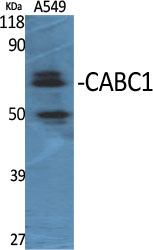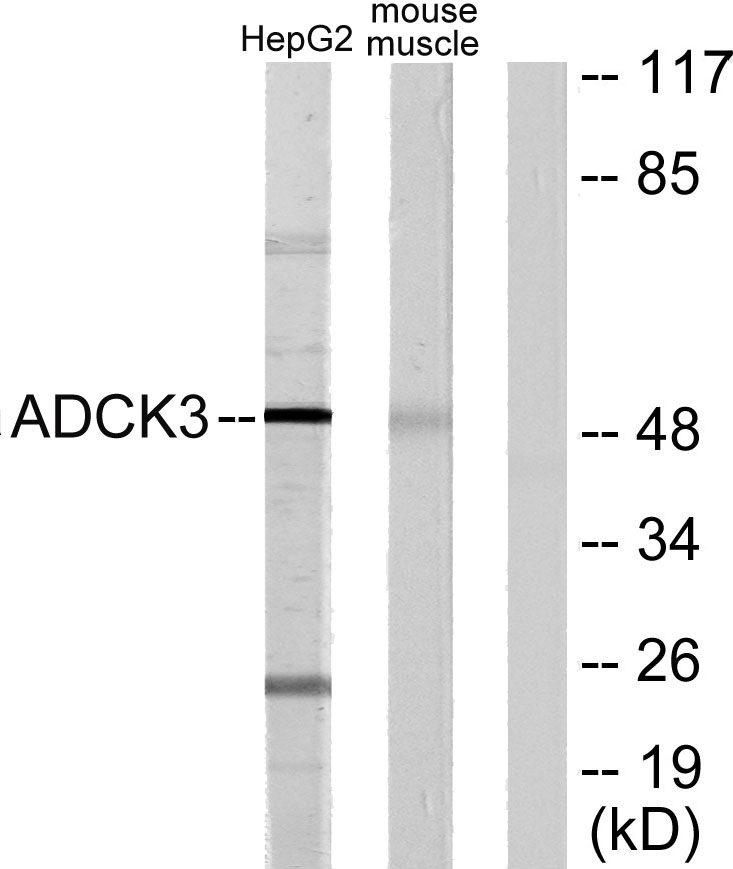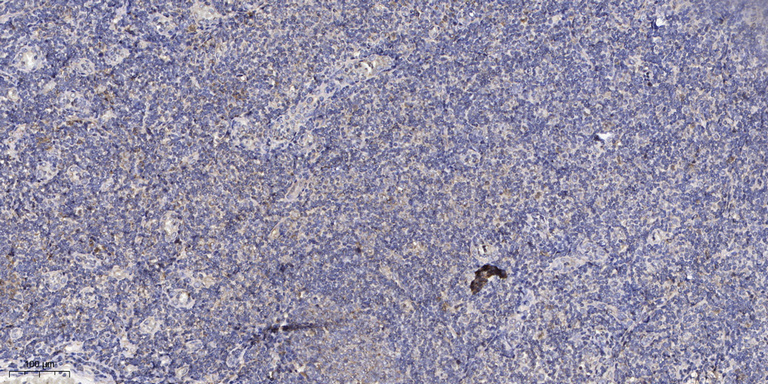CABC1 Polyclonal Antibody
- Catalog No.:YT0583
- Applications:WB;IHC;IF;ELISA
- Reactivity:Human;Mouse;Rat
- Target:
- CABC1
- Gene Name:
- ADCK3
- Protein Name:
- Chaperone activity of bc1 complex-like mitochondrial
- Human Gene Id:
- 56997
- Human Swiss Prot No:
- Q8NI60
- Mouse Gene Id:
- 67426
- Mouse Swiss Prot No:
- Q60936
- Rat Gene Id:
- 360887
- Rat Swiss Prot No:
- Q5BJQ0
- Immunogen:
- The antiserum was produced against synthesized peptide derived from human ADCK3. AA range:301-350
- Specificity:
- CABC1 Polyclonal Antibody detects endogenous levels of CABC1 protein.
- Formulation:
- Liquid in PBS containing 50% glycerol, 0.5% BSA and 0.02% sodium azide.
- Source:
- Polyclonal, Rabbit,IgG
- Dilution:
- WB 1:500 - 1:2000. IHC 1:100 - 1:300. IF 1:200 - 1:1000. ELISA: 1:10000. Not yet tested in other applications.
- Purification:
- The antibody was affinity-purified from rabbit antiserum by affinity-chromatography using epitope-specific immunogen.
- Concentration:
- 1 mg/ml
- Storage Stability:
- -15°C to -25°C/1 year(Do not lower than -25°C)
- Other Name:
- ADCK3;CABC1;PP265;Chaperone activity of bc1 complex-like; mitochondrial;Chaperone-ABC1-like;aarF domain-containing protein kinase 3
- Observed Band(KD):
- 70kD
- Background:
- This gene encodes a mitochondrial protein similar to yeast ABC1, which functions in an electron-transferring membrane protein complex in the respiratory chain. It is not related to the family of ABC transporter proteins. Expression of this gene is induced by the tumor suppressor p53 and in response to DNA damage, and inhibiting its expression partially suppresses p53-induced apoptosis. Alternatively spliced transcript variants have been found; however, their full-length nature has not been determined. [provided by RefSeq, Jul 2008],
- Function:
- disease:Defects in CABC1 are a cause of coenzyme Q10 deficiency [MIM:607426]; also known as primary CoQ10 deficiency. Coenzyme Q10 deficiency patients present a progressive neurological disorder with cerebellar atrophy, developmental delay, and hyperlactatemia.,disease:Defects in CABC1 are the cause of spinocerebellar ataxia autosomal recessive type 9 (SCAR9) [MIM:612016]; also known as autosomal recessive cerebellar ataxia type 2 (ARCA2). Spinocerebellar ataxia is a clinically and genetically heterogeneous group of cerebellar disorders. Patients show progressive incoordination of gait and often poor coordination of hands, speech and eye movements, due to degeneration of the cerebellum with variable involvement of the brainstem and spinal cord. SCAR9 is an autosomal recessive form characterized by gait ataxia and cerebellar atrophy with slow progression and few associated features. Patie
- Subcellular Location:
- Mitochondrion . Membrane ; Single-pass membrane protein .
- Expression:
- Widely expressed, with highest levels in adrenal gland, heart, pancreas, nasal mucosa, stomach, uterus and skeletal muscle.
- June 19-2018
- WESTERN IMMUNOBLOTTING PROTOCOL
- June 19-2018
- IMMUNOHISTOCHEMISTRY-PARAFFIN PROTOCOL
- June 19-2018
- IMMUNOFLUORESCENCE PROTOCOL
- September 08-2020
- FLOW-CYTOMEYRT-PROTOCOL
- May 20-2022
- Cell-Based ELISA│解您多样本WB检测之困扰
- July 13-2018
- CELL-BASED-ELISA-PROTOCOL-FOR-ACETYL-PROTEIN
- July 13-2018
- CELL-BASED-ELISA-PROTOCOL-FOR-PHOSPHO-PROTEIN
- July 13-2018
- Antibody-FAQs
- Products Images

- Western Blot analysis of various cells using CABC1 Polyclonal Antibody
.jpg)
- Western Blot analysis of COLO205 cells using CABC1 Polyclonal Antibody

- Western blot analysis of lysates from HepG2 and mouse muscle cells, using ADCK3 Antibody. The lane on the right is blocked with the synthesized peptide.

- Immunohistochemical analysis of paraffin-embedded human tonsil. 1, Antibody was diluted at 1:200(4° overnight). 2, Tris-EDTA,pH9.0 was used for antigen retrieval. 3,Secondary antibody was diluted at 1:200(room temperature, 30min).



